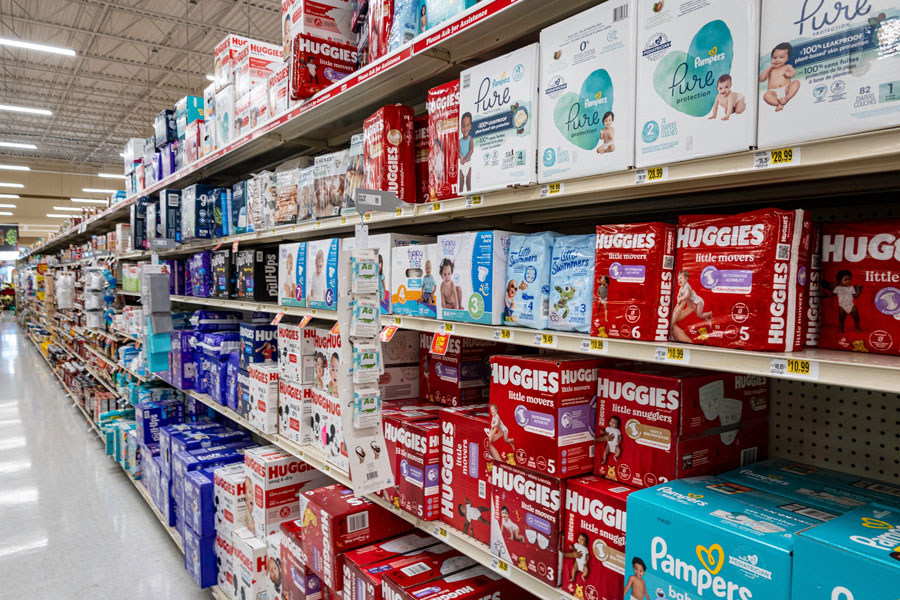
LONG ISLAND, NY – New York has made history as the first state in the nation to require ingredient labels on baby diapers, a move that consumer advocates and environmental groups are calling a major step forward in transparency and public health.
The law, signed by Governor Kathy Hochul in December 2024, mandates that all disposable and reusable diapers – along with adult incontinence products – sold in New York must clearly disclose their ingredients. The requirement applies to both packaging labels and online product listings and must be implemented no later than December 11, 2025.
Under the new legislation, manufacturers are obligated to list all intentionally added ingredients in descending order of predominance by weight. Labels must be printed in plain language, in a conspicuous format, and include percentages where applicable. Ingredients must be disclosed even if they are used in small amounts, especially if they may pose a health risk.
The law was spearheaded by State Senator Cordell Cleare and Assemblymember Linda B. Rosenthal, who previously championed a similar 2019 law requiring ingredient disclosure for menstrual products. Supporters argue that parents deserve to know what materials and chemicals are in products that come into prolonged contact with their children’s skin – especially since infants can wear more than 2,000 diapers in their first year alone.
The push for transparency comes in response to research linking some diaper materials to potentially harmful chemicals. A legislative review cited studies, including findings published in Reproductive Toxicology, which identified traces of volatile organic compounds such as methylene chloride, toluene, and xylene in certain diaper brands. These substances have raised concern due to their potential links to skin irritation, hormone disruption, and other long-term health effects.
This is about giving parents the right to make informed decisions,” Governor Hochul said in a statement. “Transparency is a public health issue.”
The law also introduces enforcement provisions. Violators could face civil fines of up to $1,000 per box or package sold without proper labeling. Some earlier bill versions included penalties tied to a percentage of a company’s annual in-state sales, though the final enforcement structure focuses on per-package violations.
New York’s new regulation echoes a growing national and international movement toward greater consumer product disclosure. Advocates hope the diaper industry will adopt labeling nationwide in response to the New York law, which could serve as a model for other states.
Industry observers note that many diaper manufacturers previously faced minimal disclosure requirements in the United States, with no federal mandate for listing ingredients on packaging. The new law fills that regulatory gap and may force companies to reformulate or reevaluate materials used in their products.
With a one-year window for implementation, manufacturers now face the task of updating packaging and online listings to comply with the law ahead of the December 2025 deadline. As New York leads the charge, pressure may build for similar measures in states like California, where environmental health laws have historically followed close behind.
Top Q&A: New York’s New Diaper Labeling Law
Q: What exactly does the new diaper law in New York require?
A: Manufacturers of disposable and reusable diapers (including adult incontinence products) must list all intentionally added ingredients on the packaging and online listings. Ingredients must appear in descending order by weight, using plain language and including percentages where applicable.
Q: When does the law go into effect?
A: The law was signed on December 11, 2024, and takes effect no later than December 11, 2025. That gives manufacturers up to one year to comply.
Q: Who is impacted by the law?
A: The law affects diaper manufacturers, retailers, and online sellers operating in New York State. Consumers will benefit from increased transparency.
Q: What types of products are covered
A: The law applies to:
- Disposable baby diapers
- Reusable cloth diapers
- Adult incontinence products
Q: What must the labels include
A: Labels must:
- Clearly list all intentionally added ingredients
- Use plain and conspicuous language
- Present ingredients in descending order by weight
- Include the percentage of each ingredient
- Be printed directly on packaging or affixed via sticker
Q: Are there any penalties for non-compliance
A: Yes. Manufacturers or retailers could face civil fines of up to $1,000 per improperly labeled package.
Q: Why was this law passed?
A: The law was driven by health and safety concerns. Research identified potentially harmful chemicals like methylene chloride, toluene, and xylene in some diapers. These substances may cause skin irritation or pose long-term risks to infants’ development.
Q: Is this the first law of its kind?
A: Yes. New York is the first U.S. state to require ingredient labeling on diapers. It builds on a 2019 New York law mandating ingredient disclosure for menstrual products.
Q: Does the law apply to online diaper sales?
A: Yes. The same ingredient disclosure requirements apply to online product listings for diapers sold in New York.
Q: Could this influence other states or federal laws?
A: Possibly. New York’s leadership on product transparency often sets the stage for nationwide adoption or similar laws in states like California, Washington, or Oregon.


